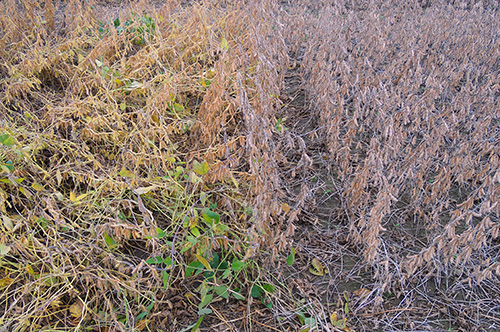By Mike Staton, Soybean Educator
Several factors have combined to cause soybeans to lodge in some areas of Michigan in 2016 (Photo 1). Lodged soybeans slow down harvest operations and lead to harvest losses as the plants are more difficult to cut and gather into the combine. Soybean producers can reduce harvest losses due to lodging by carefully adjusting and operating their combines. The latest Michigan State University Extension recommendations for reducing harvest losses in lodged soybeans are listed below.
Decrease your ground speed to 2.5-3 mph.
Position the cutter bar as close to the ground as possible.
Angle the pickup fingers on the reel back slightly to more aggressively pull the lodged plants to the cutter bar. Reduce the angle of the fingers if the plants are riding over the top of the reel.
Run the reel axle 9-12 inches ahead of the cutter bar.
Contact the manufacturer for specific recommendations if using an air-assisted reel.
Operate the reel as low as necessary to pick up lodged plants without causing them to ride over the top of the reel. Raise the reel if this happens.
Consider installing vine lifters on the cutter bar if the plants are severely lodged.
If the plants are badly lodged in one direction, try adding vine lifters to the cutter bar and harvesting at a 30 degree angle to the direction of the lodging. If this doesn’t work, harvest all of the lodged plants in the direction opposite to way they are leaning.
Try increasing the reel speed in relation to the ground speed. This sounds easy, but it can be challenging to find the correct ground speed and reel speed combination in lodged beans having brittle pods. If the ground speed is too fast in relation to the speed of the reel, the cutter bar will ride over some of the plants. If the reel speed is set too fast in relation to the ground speed, the reel can beat the beans out of the pods.
The reel should run 10- 20% faster than the ground speed under ideal conditions. However, if the beans are lodged, increase the reel speed incrementally up to a maximum of 50% faster than the ground speed if necessary. If the reel is causing shattering, decrease the speed of the reel just to the point that the shattering stops. If the cutter bar begins riding over lodged plants, you will need to decrease your ground speed.
Make one adjustment at a time and stop frequently to evaluate your progress towards reducing gathering losses.

Varietal effect on lodging. Photo by Mike Staton, MSU Extension.
Finally, growers that had significant lodging at harvest should try to identify the cause or causes of the lodging. The most likely causes are excessive rainfall or irrigation during the vegetative stages, high populations, low potassium soil test levels and variety selection. Soybean varieties differ in their susceptibility to lodging and growers should consider this characteristic when selecting varieties.
Varietal differences are clearly depicted in the photo taken at the MSU soybean variety performance trial near Hamilton, Mich. The two varieties were planted at the same planting rate (160,000 seeds per acre), fertilized the same and experienced the same weather conditions. However, the variety on the left is badly lodged and the variety on the right is standing well. Planting date may affect the potential to lodge as mid-May to mid-June planting dates generally produce the tallest plants.





